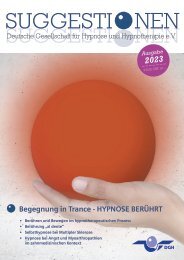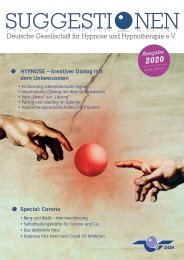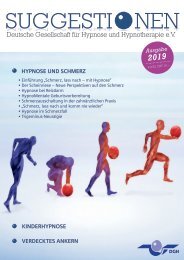SUGGESTIONEN Ausgabe 2018
Erfolgreiche ePaper selbst erstellen
Machen Sie aus Ihren PDF Publikationen ein blätterbares Flipbook mit unserer einzigartigen Google optimierten e-Paper Software.
52<br />
Literaturübersicht Wissenschaft<br />
Literaturübersicht Wissenschaft<br />
753<br />
Literaturübersicht<br />
Wissenschaft<br />
Auch im letzten Jahr wurde auf<br />
dem Gebiet der Hypnose wieder<br />
eifrig geforscht. Größtenteils sind<br />
aber inzwischen die Fragestellungen<br />
zu speziell geworden, um für<br />
unsere Leser von allgemeinem Interesse<br />
zu sein. Das zeigt natürlich<br />
andererseits, dass es schon<br />
längst nicht mehr nur darum<br />
geht zu untersuchen, ob Hypnose<br />
überhaupt funktioniert, sondern<br />
jetzt rücken Mechanismen und<br />
Zusammenhänge auf molekularer<br />
Ebene in den Fokus. Beispiele<br />
dafür sind die drei anschließend<br />
Zinaida I. Storozheva, Anna V. Kirenskaya, Mikhail N. Gordeev, Maria E. Kovaleva & Vladimir Yu<br />
Novototsky-Vlasov (<strong>2018</strong>) COMT Genotype and Sensory and Sensorimotor Gating in High and<br />
Low Hypnotizable Subjects, International Journal of Clinical and Experimental Hypnosis,<br />
66:1, 83-105<br />
Abstract<br />
zitierten Arbeiten. Hier zeigt<br />
sich, dass unterschiedliche Ausprägungen<br />
der Hypnotisierbarkeit<br />
mit Variationen der Katechol-O-Methyltransferase<br />
(COMT)<br />
und damit dem dopaminergen<br />
System bzw. der Ausprägung der<br />
Stresshormone (Adrenalin, Noradrenalin,<br />
Dopamin) oder auch<br />
den Polymorphismen der Opioid-Rezeptoren<br />
korreliert sind. Das<br />
könnte letztlich bedeuten, dass<br />
Hypnotisierbarkeit auch eine genetisch-molekulare<br />
Komponente<br />
haben könnte. Das Thema ist<br />
auch für mich persönlich sehr interessant,<br />
weil ich vor 35 Jahren<br />
über die Nachweismöglichkeiten<br />
von Katecholaminen promoviert<br />
habe und damals noch niemand<br />
im Traum an solche möglichen<br />
Auswirkungen gedacht hat.<br />
We investigated the association between hypnotizability, COMT polymorphism, P50 suppression<br />
ratio, and prepulse inhibition of acoustic startle response (ASR) in 21 high (HH) and 19 low (LH)<br />
hypnotizable subjects. The frequency of Met/Met carriers of COMT polymorphysm was higher in<br />
HH than in LH group (33.3% versus 10.6%, p = .049).<br />
Increased ASR amplitude and latency and decreased prepulse inhibition at 120 ms lead interval<br />
were found in the HH compared to the LH group. The effect of COMT genotype on prepulse<br />
inhibition was observed in LH group only. No between-group differences in P50 measures were<br />
found. The obtained results suppose the participation of dopamine system in mechanisms of<br />
hypnotizability and different allocation of attentional resources in HH and LH subjects.<br />
E. R. Katonai, Anna Szekely, A. Vereczkei, Maria Sasvari-Szekely, Éva I. Bányai & Katalin Varga<br />
(2017) Dopaminergic and Serotonergic Genotypes and the Subjective Experiences of<br />
Hypnosis, International Journal of Clinical and Experimental Hypnosis, 65:4, 379-397<br />
Abstract<br />
Hypnotizability is related to the Val158 Met polymorphism of the COMT gene. The authors’ aim<br />
was to find associations between candidate genes and subjective dimensions of hypnosis; 136<br />
subjects participated in hypnosis and noninvasive DNA sampling. The phenomenological<br />
dimensions were tapped by the Archaic Involvement Measure (AIM), the Phenomenology of<br />
Consciousness Inventory (PCI), and the Dyadic Interactional Harmony Questionnaire (DIH).<br />
The main results were that the “Need of dependence” subscale of AIM was associated with the<br />
COMT genotypes. The GG subgroup showed higher scores, whereas AA had below average scores<br />
on the majority of the subjective measures. An association between the 5-HTTLPR polymorphism<br />
and the intimacy scores on the DIH was also evident. The effects are discussed in the<br />
social–psychobiological model of hypnosis.<br />
Silvano Presciuttini, Michele Curcio, Rosalia Sciarrino, Fabrizio Scatena, Mark P. Jensen &<br />
Enrica L. Santarcangelo (<strong>2018</strong>) Polymorphism of Opioid Receptors μ1 in Highly Hypnotizable<br />
Subjects, International Journal of Clinical and Experimental Hypnosis, 66:1, 106-118<br />
Abstract<br />
The possible cooperation between hypnotizability-related and placebo mechanisms in pain<br />
modulation has not been consistently assessed. Here, we investigate possible genetic bases for<br />
such cooperation. The OPRM1 gene, which encodes the μ1 opioid receptor—the primary site of<br />
action for endogenous and exogenous opioids—is polymorphic in the general population for the<br />
missense mutation Asn40Asp (A118G, rs1799971).<br />
The minor allele 118G results in decreased levels of OPRM1 mRNA and protein.<br />
As a consequence, G carriers are less responsive to opioids.<br />
The aim of the study was to investigate whether hypnotizability is associated with the presence of<br />
the OPRM1 polymorphism. Forty-three high and 60 low hypnotizable individuals, as well as 162<br />
controls, were genotyped for the A118G polymorphism of OPRM1.<br />
The frequency of the G allele was significantly higher in highs compared to both lows and controls.<br />
Findings suggest that an inefficient opioid system may be a distinctive characteristic of highs and<br />
that hypnotic assessment may predict lower responsiveness to opioids.<br />
>>

















